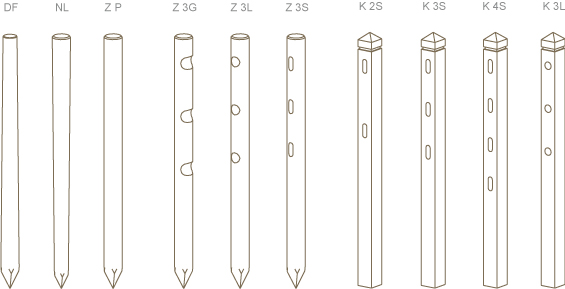How to choose a quality fence post?
Discover here the Dos and Don’ts of choosing the right fence post.
The post is the keystone of an enclosure fence. That’s why it must be chosen carefully. Four factors can determine its quality: selection, drying, species and wood impregnation. Discover here the Dos and Don’ts of choosing the right fence post.
Carefully selected wood
While designing your future enclosure fence, you define its height, the distance between the posts and the number of rails. Those factors determine the height and the diameter of the post. They have a direct impact on the trunks selection: those too short or with a diameter that does not match the plan will be put aside.
First of all, trunks with too much taper, i.e. those with too much difference between the higher and the lower diameter, are not suitable for fence posts, since they cannot be peeled properly (only the thicker part of the post would be peeled).
Companies specialized in wood treatment, like Peter Müller, work with sorting machines that automatically measure the trunks and sort them according to pre-defined dimensions.
A dry trunk with a moisture content of 20%
When the wood for the posts arrives to the factory, its moisture content reaches 60%, thus its cells are full of water. It is therefore impossible to apply the impregnation product. A careful drying of the posts will lower the moisture content to less than 20% and the empty cells will allow a more efficient impregnation. In addition, the drying creates microcracks that help the product soaking.
The posts must dry in open air during at least three months to obtain a satisfying result. At Peter Müller, we work with industrial drying machines to reduce the drying period to one week, and also obtain a more even drying.
Choose the species according to the posts shape
Before choosing the species, it is necessary to choose the type of post you want for the future fence: peeled, square or machine rounded. That information is essential, since all species are not suitable for all types of posts.

Every trunk has two layers. The first is the sapwood, the living part of the tree. It is a softer wood through which the tree receives the sap. The inner layer is the heartwood, also called duramen, which is harder. Depending on the species, the sapwood share can vary. It is quite thick in pines while there is only a thin layer in spruces.
What does the sapwood have to do with the type of post and its quality? The sapwood is the layer that can be impregnated, unlike the heartwood, which is too hard. A thin sapwood layer suffices for a peeled post. As a result, spruce would be chosen in that case. On the other hand, for machine rounded posts, a thicker layer of sapwood is needed; since part of the wood is removed (40% on average) in order to shape a cylindrical, even post. That also explains why trunks with too much taper are eliminated since the beginning. For square posts we’d go for local pine trunks and spruce is the best choice in all other cases.
Since their lifespan in the natural state can reach 25 years, tropical woods, while more expensive than local ones, are an excellent solution for owners who do not want to impregnate the wood.
Salt impregnation
Today, chromium salt impregnation (olive green) or salt colour (brown or dark) impregnation is the only option. The posts have a 7 to 10 years lifespan.
Durafence posts are protected by the DeepProtect process.
In short
The characteristics of your future enclosure fence have a direct impact on the choice of the ideal post. Therefore, it is important to carefully design the fence from the beginning, in order to be able to determine the shape, impregnation, length, diameter and wood species that better suit your project. At Peter Müller, we advise our customers at home, so that we personally get a sense of the future fence and its position. In addition, a professional processing of the DURAPost posts, particularly concerning the selection, the drying and the wood impregnation, is essential to maximize their lifespan.
More questions? Contact us without obligation.
Share onFacebookWhatsAppLinkedIn